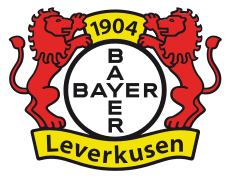Bayer Leverkusen
 |
|
| Full name | Bayer 04 Leverkusen Fußball GmbH |
|---|---|
| Founded | 1 July 1904 |
| Ground | BayArena |
| Capacity | 30,210 |
| Owner | Bayer AG |
| Chairman | Michael Schade |
| Head Coach | Roger Schmidt |
| League | Bundesliga |
| 2015–16 | 3rd |
| Website | Club home page |
Bayer 04 Leverkusen Fußball GmbH, also known as Bayer 04 Leverkusen [ˌbaɪ̯ɐ ˈleːvɐˌkuːzn̩], Bayer Leverkusen, Leverkusen or simply Bayer, is a German football club based in Leverkusen, North Rhine-Westphalia. The club plays in the Bundesliga, the top tier of the German football league system, and hosts matches at the BayArena.
The club was founded in 1904 by employees of the German pharmaceutical company Bayer, whose headquarters are in Leverkusen and from which the club draws its name. It was formerly the best-known department of TSV Bayer 04 Leverkusen, a sports club whose members also participate in athletics, gymnastics, basketball and other sports including the RTHC Bayer Leverkusen (rowing, tennis and hockey). In 1999 the football department was separated from the sports club and is now a separate entity formally called Bayer 04 Leverkusen GmbH.
Bayer Leverkusen have won one DFB-Pokal and one UEFA Cup. Their local rivals are 1. FC Köln.
On 27 November 1903, Wilhelm Hauschild wrote a letter – signed by 170 of his fellow workers – to his employer, the Friedrich Bayer and Co., seeking the company's support in starting a sports club. The company agreed to support the initiative, and on 1 July 1904 Turn- und Spielverein Bayer 04 Leverkusen was founded. On 31 May 1907, a separate football department was formed within the club. In the culture of sports in Germany at the time, there was significant animosity between gymnasts and other types of athletes. Eventually this contributed to a split within the club: on 8 June 1928, the footballers formed a separate association – Sportvereinigung Bayer 04 Leverkusen – that also included the handball and fistball players, athletics, and boxing, while the gymnasts carried on as TuS Bayer 04 Leverkusen. SV Bayer 04 Leverkusen took with them the club's traditional colours of red and black, with the gymnasts adopting blue and yellow.
...
Wikipedia
